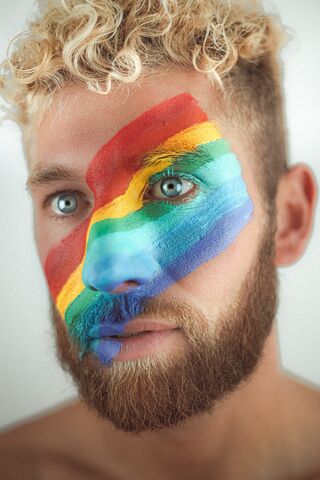Identity
Is the B in LGBTQ Being Erased?
New research explores acceptance and erasure of bisexual men and women.
Posted June 29, 2021 Reviewed by Abigail Fagan
Key points
- Bisexual men and women often experience their sexual identity being dismissed or discounted, causing feelings of invisibility.
- Bisexual erasure refers to actions and beliefs that deny, question, or reject bisexual identities. It exists in LGBTQ and non-LGBTQ communities.
- New research suggests that bisexual men face greater levels of bisexual erasure than bisexual women.
This article was co-authored with Erin Fitzgerald and Bre O'Handley of Trent University.
If you were to stop and think about the sexuality of some of the most well-known athletes, actresses, and actors, who would come to mind? If you were to picture celebrities like Megan Fox, Angelina Jolie, or Tyler Blackburn, would you notice any commonalities between them? Did you know that all three are openly bisexual?
Questions like these were asked by an openly bisexual sportswriter for the Athletic, Jeff Rueter. Knowing the importance of visibility, especially in sport, Rueter would often “test people [by asking them to] ‘name a bisexual man and don’t say Frank Ocean.’” Almost everyone he asked was left speechless.
Although the lack of responses shocked Rueter, the need for representation inspired young bisexual athletes seeking to increase bisexual visibility in sports. University athletes Andrew Ford and Jack Storrs embraced Rueter’s challenge by publicly identifying as bisexual and soon several others followed suit. There is a new generation of bisexual athletes who are open, visible and fighting against continued bisexual erasure.
What Is Bisexual Erasure?
Bisexual erasure is the denial, questioning, and rejection of bisexual identities and it remains prevalent. Contributing to bisexual erasure is the view that bisexuals are confused or are not fully committed to being straight, lesbian, or gay. Binary views of gender (men/women) and sexuality (gay/straight) contribute to the sense that sexuality cannot fall “in-between,” despite consistent polling showing that bisexuality is one of the most common sexual identities.

The myth that bisexuals are struggling to find their true sexuality prevails. Such myths lead to bisexual women being labelled as “experimenting” or “wanting the attention of men.” Terms like “LUG: lesbian until graduation,” and “bar sexual” are used to characterize and diminish the identities of bisexual women, while bisexual men are often perceived to be on a “stepping stone” to their “true” gay identity.
Such stereotypes directly contribute to the erasure of bisexual identities and are unfortunately all too familiar for bisexual individuals. The newly-out athletes, Andrew Ford and Jack Storrs, described feeling questioned when they came out. Ford stated that he was “questioned by the gay community and fetishized [by women],” and Storrs had similar experiences with “people [suggesting] he was on his way to identifying as gay.”
These beliefs are prevalent both beyond and within the LGBTQ community. When Andrew Ford publicly identified as bisexual, LGBTQ+ folks responded by “insisting he wasn’t being honest with himself.” Thus, anecdotal experiences point to bisexual erasure continuing to be a burden for bisexual individuals, but what does the research say about this phenomenon?
Indicators of Bisexual Erasure: Current Research
A recent study published in the European Journal of Social Psychology investigated beliefs about bisexuality as well as the tendency to dismiss bisexual identities as a function of gender. Participants in the study read a dating profile of an individual named “Sam,” who was openly bisexual. Participants were asked to rate Sam’s likely level of sexual and romantic attraction towards other dating profiles of men and women.
The catch was that some participants were told that Sam was a man and others were told that Sam was a woman. The researchers were interested in seeing how viewing Sam as either a bisexual man or a bisexual woman would influence participants’ expectations for Sam’s attractions to either men or women.
When Sam was identified as a bisexual man, participants were more likely to indicate that Sam would have a stronger attraction to other men and be more likely to select a man over a woman for a sexual encounter. When Sam was identified as a bisexual woman, participants perceived Sam as being equally attracted to men and women, but similar to when Sam was identified as a man, participants perceived the female version of Sam to be more likely to choose another woman for a sexual encounter. When it came to who Sam would pick for a romantic relationship, participants rated both the male and female versions of Sam as equally likely to choose either a man or woman as a partner.
The researchers interpreted the tendency of participants to perceive a preference for one gender over the other as a form of bisexual erasure, as the participants were essentially ascribing a "leaning" towards a gay or lesbian identity, despite the open identification as bisexual in both versions of Sam’s profile. While the results for bisexual men were in line with common stereotypes of bisexual men “truly being gay,” the findings for bisexual women were somewhat surprising, as when a preference for one gender or another was perceived, it was in the direction of a same-sex attraction, which runs counter to the common stereotypes that deny women’s bisexuality in favour of assuming a "true" attraction to men.
In addition to assessing participants’ perceptions of a bisexual man or woman’s attractions, the study also asked more explicit questions concerning bisexual erasure. Participants rated their agreement with the following statements: “Most bisexual women will end up in a heterosexual marriage” and, “Most bisexual men just haven’t come out as gay yet.” Participants were more likely to endorse the second statement over the first, indicating a greater likelihood of erasing bisexuality in men than in women.
While most of the findings from this study were in line with other research in bisexual erasure and the experiences that bisexual individuals face on a daily basis, having to defend and justify their identity, some of the results suggest that things may be beginning to change. This is most clearly found in the findings that when bisexual Sam was identified as a woman, participants perceived Sam as being equally attracted to men and women and equally likely to engage in a romantic relationship with either a man or a woman, rather than reverting to the standard assumptions that bisexual women will eventually settle on their "true heterosexual" identity.
Nonetheless, the study demonstrates that the erasure of bisexual identities is still prevalent today. Despite a slight change in the acceptance of bisexual women, bisexual men are still overwhelmingly thought of as “bi now, gay later —and this is echoed by bisexual individuals themselves, like Andrew Ford and Jack Storrs, who constantly feel the invisibility of their identity. The consequences of constantly feeling that one's identity is dismissed can contribute to increased minority stress and reduced mental well-being.
Thus, while we have come a long way in acknowledging the damage that can be caused by other forms of sexual prejudice, more work is needed to reduce bisexual erasure both within and beyond the boundaries of the LGBTQ+ community.
References
Morgenroth, T., & Kirby, T. (2021). Bisexual erasure: Perceived attraction patterns of bisexual women and men. European Journal of Social Psychology. Online First.
Galupo, M. P., Ramirez, J. L., & Pulice-Farrow, L. (2017). "Regardless of their gender": Descriptions of sexual identity among bisexual, pansexual, and queer identified individuals. Journal of Bisexuality, 17(1), 108-124.




